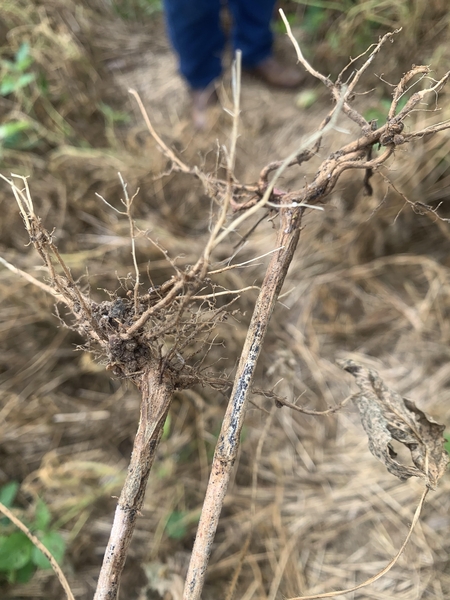Introduction
Soybean stem canker was first reported in Iowa in the 1940’s and has since been found in most soybean growing regions. In severe cases, stem canker has resulted in yield losses up to 80% on susceptible cultivars in conducive environments. The greatest losses often occur when soybeans are infected in early vegetative growth stages as it can often lead to significant stand loss. Infection during reproductive stages can also lead to yield loss and reductions in seed quality.
Cause-Pathogen and Disease Cycle
Soybean stem canker is caused by multiple Diaporthe species though is often categorized as either northern or southern stem canker caused by the fungal pathogens Diaporthe phaseolorum var. caulivora and Diaporthe phaseolorum var. meridionalis, respectively.
Diaporthe spp., that causes stem canker can survive in host residue and/or in the soil for several years. The primary source of the fungus is within the infested residue; however, it has been reported that seed can also be infected. The fungus overwintering in infested residue, or the soil produces spores during rainy weather and dispersed onto the lower stem of the plant through rain splash. The disease favors extended periods of wet weather early in the growing season and is primarily when infection takes place. Wet weather and moisture are drivers of disease development as infection can occur over a wide range of temperatures. Secondary spore production can occur on the infected plant tissue though secondary infections have little impact on disease development.
Signs and Symptoms
Wilted and dead plants with leaves still attached to the petioles are often the first symptoms observed late in the season and typically occur sporadically in patches within a field (Figure 1). Though, initial symptoms of infection are reddish-brown lesions that can be observed on the stem during late vegetative growth stages and into reproductive growth stages (Figure 2). As the disease progresses, the lesions expand turning dark brown or black in color and can extend over several nodes. The lesions become sunken cankers that girdle the stem, killing the plant. Small black spots (stroma, fruiting bodies) may also appear on the dead tissue in the sunken cankers (Figure 3). Upon infection, interveinal chlorosis may be a foliar symptom that becomes necrotic as the disease progresses.
Management
Management of stem canker is best accomplished by planting resistant varieties though other practices that are effective include crop rotations away from soybeans to non-host crops such as corn, wheat, and sorghum for at least two years. If there is a history of severe stem canker outbreaks within a field, it is recommended to avoid rotating with alfalfa as well as it can also serve as host of the pathogen.
Fungicides typically have been reported to have little to no efficacy when managing stem canker; however, moderately resistant varieties accompanied with a well-timed fungicide application at early vegetative stages have been reported to effectively protect against stem canker.
Minimally tilled, and/or no-tilled production areas are at higher risk of disease development due to the capability of the pathogen to survive in infested residue. Fields high in organic matter are also at a higher risk of infection therefore, monitoring and maintaining adequate fertility could reduce risk and impact of disease.
Useful Resources
- The NC State University Plant Disease and Insect Clinic provides diagnostics and control recommendations
- The NC State Extension Plant Pathology portal provides information on crop disease management
- The North Carolina Agricultural Chemicals Manual provides pesticide information for common diseases of North Carolina. The manual recommendations do not replace those described on the pesticide label, and the label must be followed.
Publication date: Dec. 6, 2016
Reviewed/Revised: Sept. 21, 2023
N.C. Cooperative Extension prohibits discrimination and harassment regardless of age, color, disability, family and marital status, gender identity, national origin, political beliefs, race, religion, sex (including pregnancy), sexual orientation and veteran status.



